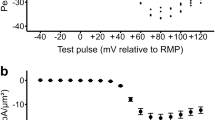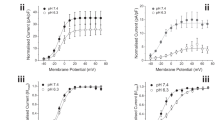Abstract
SINCE their discovery in cardiac muscle1, ATP-sensitive K+(KATP) channels have been identified in pancreatic β-cells2, skeletal muscle3, smooth muscle4and central neurons5. The activity of KATP channels is inhibited by the presence of cytosolic ATP. Their wide distribution indicates that they could have important physiological roles that may vary between tissues. In muscle cells the role of K+ channels is to control membrane excitability and the duration of the action potential. In anoxic cardiac ventricular muscle KATPchannels are believed to be responsible for shortening the action potential6, and it has been proposed that a fall in ATP concentration during metabolic exhaustion increases the activity of KATP channels in skeletal muscle7, which may reduce excitability. But the intracellular concentration of ATP in muscle is buffered by creatine phosphate to 5–10 mM, and changes little, even during sustained activity8. This concentration is much higher than the intracellular ATP concentration required to half block the KATP-channel current in either cardiac muscle (0.1 mM)1 or skeletal muscle (0.14 mM)9, indicating that the open-state probability of KATP channels is normally very low in intact muscle. So it is likely that some additional means of regulating the activity of KATP channels exists, such as the binding of nucleotides other than ATP10–12. Here I present evidence that a decrease in intracellular pH (pHi) markedly reduces the inhibitory effect of ATP on these channels in excised patches from frog skeletal muscle. Because sustained muscular activity can decrease pHi by almost 1 unit13,14 in the range at which KATP channels are most sensitive to pHi it is likely that the activity of these channels in skeletal muscle is regulated by intracellular protons under physiological conditions.
This is a preview of subscription content, access via your institution
Access options
Subscribe to this journal
Receive 51 print issues and online access
$199.00 per year
only $3.90 per issue
Buy this article
- Purchase on Springer Link
- Instant access to full article PDF
Prices may be subject to local taxes which are calculated during checkout
Similar content being viewed by others
References
Noma, A. Nature 305, 147–148 (1983).
Cook, D. L. & Hales, C. N. Nature 311, 271–273 (1984).
Spruce, A. E., Standen, N. B. & Stanfield, P. R. Nature 316, 736–738 (1985).
Standen, N. B. et al. Science 245, 177–180 (1989).
Sturgess, N. C., Hales, C. N. & Ashford, M. L. T. Pflugers Arch. ges. Physiol. 409, 607–165 (1987).
Noma, A. & Shibasaki, T. J. Physiol., Lond. 363, 463–480 (1985).
Castle, N. A. & Haylett, D. G. J. Physiol., Lond. 383, 31–43 (1987).
Carlson, F. D. & Siger, A. J. gen. Physiol. 44, 33–60 (1960).
Spruce, A. E., Standen, N. B. & Stanfield, P. R. J. Physiol., Lond. 382, 213–237 (1987).
Dunne, M. J. & Petersen, O. H. FEBS Lett. 208, 58–62 (1986).
Dunne, M. J. & Petersen, O. H. Pflugers Arch. ges. Physiol. 407, 564–565 (1986).
Kakei, M., Kelly, R. P., Ashcroft, S. J. H. & Ashcroft, F. M. FEBS Lett. 208, 63–66 (1986).
Pan, J. W., Hamm, J. R., Rothman, D. L. & Shulman, R. G. Proc. natn. Acad. Sci. U.S.A. 85, 7836–7839 (1988).
Renaud, J. M. J. Physiol., Lond. 416, 31–47 (1989).
Hamill, O. P., Marty, A., Neher, E., Sakmann, B. & Sigworth, F. J. Pflugers Arch. ges. Physiol. 391, 85–100 (1981).
Standen, N. B., Stanfield, P. R., Ward, T. A. & Wilson, S. W. Proc. R. Soc. B221, 455–464 (1984).
Findlay, I. Pflugers Arch. ges. Physiol. 410, 313–320 (1987).
Challis, R. A. J., Vranic, M. & Radda, G. K., Am. J. Physiol. 256, E129–E137 (1989).
Moody, W. J. A. rev. Neurosci. 7, 257–278 (1984).
Cook, D. L., Masatoshi, I. & Fujimoto, W. Y. Nature 311, 269–271 (1984).
Christensen, O. & Zeuthen, T. Pflugers Arch. ges. Physiol. 408, 249–259 (1987).
Misler, S., Gillis, K. & Tabcharni, J. J. Membrane Biol. 109, 135–143 (1989).
Carbone, E. & Lux, H. D. J. Physiol., Lond. 386, 547–570 (1987).
Colquhoun, D. & Sigworth, F. J. in Single Channel Recording (eds Neher, E. & Sakmann, B.) 191–263 (Plenum, New York, 1983).
Author information
Authors and Affiliations
Rights and permissions
About this article
Cite this article
Davies, N. Modulation of ATP-sensitive K+ channels in skeletal muscle by intracellular protons. Nature 343, 375–377 (1990). https://doi.org/10.1038/343375a0
Received:
Accepted:
Issue Date:
DOI: https://doi.org/10.1038/343375a0
This article is cited by
-
Definitions and pathophysiology of vasoplegic shock
Critical Care (2018)
-
The effects of endurance exercise in hypoxia on acid-base balance and potassium kinetics: a randomized crossover design in male endurance athletes
Sports Medicine - Open (2018)
-
ATP-sensitive muscle afferents activate spinal trigeminal neurons with meningeal afferent input in rat – pathophysiological implications for tension-type headache
The Journal of Headache and Pain (2016)
-
The prognostic value of muscle StO2 in septic patients
Intensive Care Medicine (2007)
-
Kir6.2 Channel Gating by Intracellular Protons: Subunit Stoichiometry for Ligand Binding and Channel Gating
Journal of Membrane Biology (2006)
Comments
By submitting a comment you agree to abide by our Terms and Community Guidelines. If you find something abusive or that does not comply with our terms or guidelines please flag it as inappropriate.



